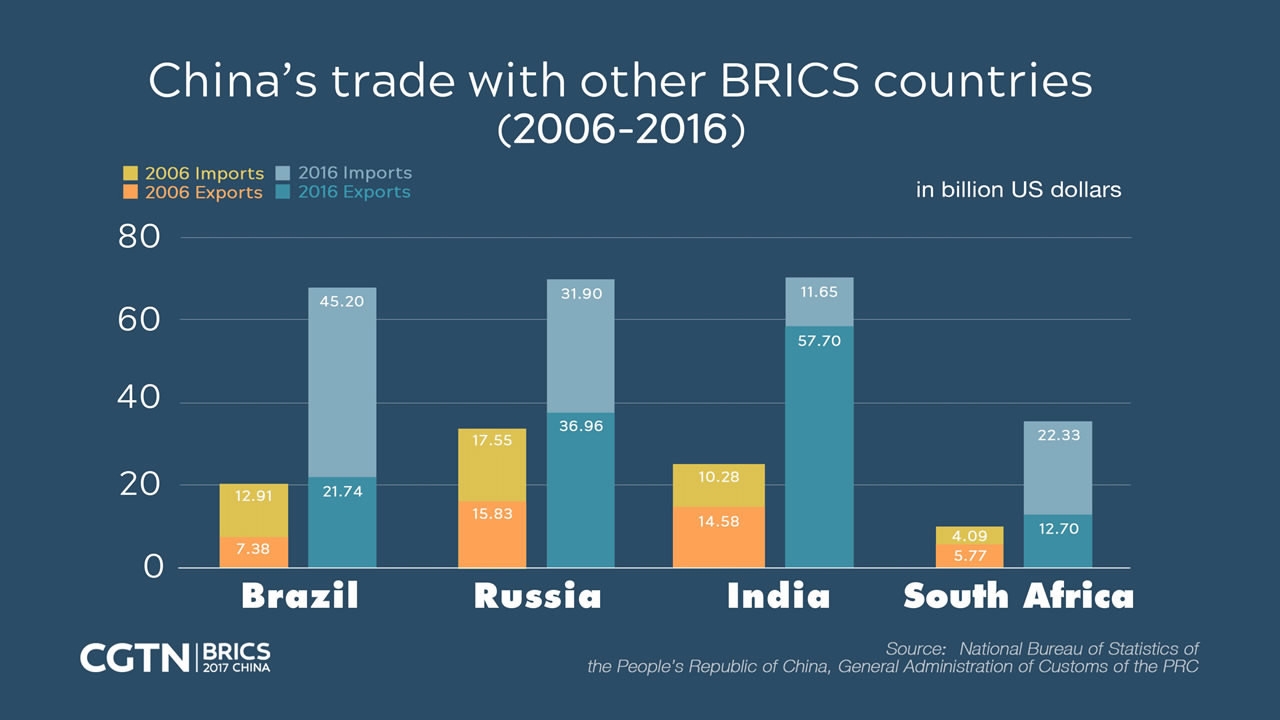
Business
20:25, 01-Sep-2017
Debunking China Myths: the potential for disunity or the mantle of globalization?
By CGTN’s Wang Yue

The acronym BRICS represents group of five major emerging national economies: Brazil, Russia, India, China and South Africa, a promising bloc of emerging economies that is set to create a multi-polar world.
Nearly, 42 percent of the world’s population lives in BRICS nations and they constitute one fifth of the world's economy.
A decade after the emergence of the bloc, two member countries are facing recession and political turmoil. Experts claim that disparity in development among bloc members will lead to difference of opinion and disunity. While pro-BRICS experts feel emerging economies will to take over the mantle of globalization and slowly improve their governance.
As the ninth BRICS summit begins on Sunday in China's southeastern city of Xiamen, summit’s outcome may prove BRICS doubters wrong?

VCG Photo
VCG Photo
Is BRICS too “China-centric”?
Few experts called BRICS “China-centric,” as China is active in developing the bloc and seems the most outstanding country in the bloc. Is it appropriate to call BRICS “China-centric”?
Surprisingly, answer can be “YES”!
China’s contribution to BRICS is hard to ignore. From 2006 to 2016, Chinese imports from Brazil almost quadrupled to 45.20 billion US dollars, while those from South Africa more than quintupled to 22.33 billion US dollars. Imports to and exports from Russia also saw a major boost, while exports to India shot up to 57.70 billion US dollars.
Russian President Vladimir Putin, in a signed article, also appreciated China's significant contribution, "which has allowed the BRICS countries as a group to move forward in all key areas of our partnership, including politics, economy and culture".
Cheng Cheng, an associate research fellow at the Chongyang Institute for Financial Studies, “China is 11-trillion-US-dollars economy. If you put this scale of economy into any group of countries, it will be ‘China-centric’.”

CGTN Photo
CGTN Photo
But the answer “NO” co-exists.
“I think for China, it is not so centric. Russia and India still inflate BRICS. As to South Africa and Brazil, these two want to exit from the recession. To some extent, China is just successful in the model of developing economy, and just plays the role of helping others,” said Professor Wu Fei from Jinan University.
Cheng also agrees with Wu. And in other words, Cheng preferred to name such assistance as “cooperation,” since China also learnt and gained from its fellow members.
“We have learnt a lot from those BRICS member countries. It’s not like one way thing. We are providing assistance to those countries, and we are also learning and getting help and experience from other countries,” Cheng stated.

Is development disparity a “villain” to BRICS? –Divergence means survival
The BRICS countries' combined international trade climbed to 16 percent in 2015 from 11 percent in 2009. Their capital investment in the global markets has also increased significantly from seven percent to 12 percent. And during the same period, the BRICS' contribution to the global economic growth has steadily been above fifty percent.
However, while economic performances of China and India are excellent, Russia and Brazil are struggling with economic recessions. Experts also worry that development disparity may threaten BRICS survival.
According to Cheng, development disparity is like a storm in a teapot. “We did see divergence among the BRICS countries. Some are growing very fast, like China and India. Some are a little bit lying behind. But I don’t see this as a problem.

VCG Photo
VCG Photo
The divergences actually create opportunities for cooperation, since they can learn from each other for their experiences, changing their capacities, and providing resources for their infrastructure building. These are very crucial,” Cheng explained.
Cheng’s opinion is not “a fanciful notion”. International Monetary Fund (IMF) said it expected the BRICS countries to contribute 75 percent to global economic growth. And Russia and Brazil will slowly emerge out of their recession and return to positive growth index.
“A man grows up by learning, by doing, by mistakes. And that’s how BRICS grows,” Cheng told CGTN.

Chinese Foreign Minister Wang Yi, August 30, Beijing, China. /VCG Photo
Chinese Foreign Minister Wang Yi, August 30, Beijing, China. /VCG Photo
Is BRICS Plus a paper-baby?
Chinese Foreign Minister Wang Yi said China would explore expansion modalities for "BRICS Plus" and build a wider partnership by holding dialogues with other major developing countries and organizations, so as to turn BRICS into the most-influential platform for South-South cooperation in the world.
Wu has strong confidence on the BRICS Plus, stressing that “it will work”.
“BRICS Plus means we can invite all our friends. For example, Russia can invite Kazakhstan and Tajikistan. And South Africa thinks they can use BRICS Plus to develop the whole African economy.”

“BRICS has its own bank –New Development Bank (NDB). They have own budget, own plan and proposal. And if other countries can join, they can share the development of countries,” Wu noted.
“To keep or increase the relevant of BRICS as the main platform for cooperation and all those emerging economies, we must include other fast growing developing economies. Otherwise, in the long-term, BRICS might lose its own advantages,” Cheng added.
Read more about the Debunking China Myths stories:
33km

SITEMAP
Copyright © 2018 CGTN. Beijing ICP prepared NO.16065310-3
Copyright © 2018 CGTN. Beijing ICP prepared NO.16065310-3